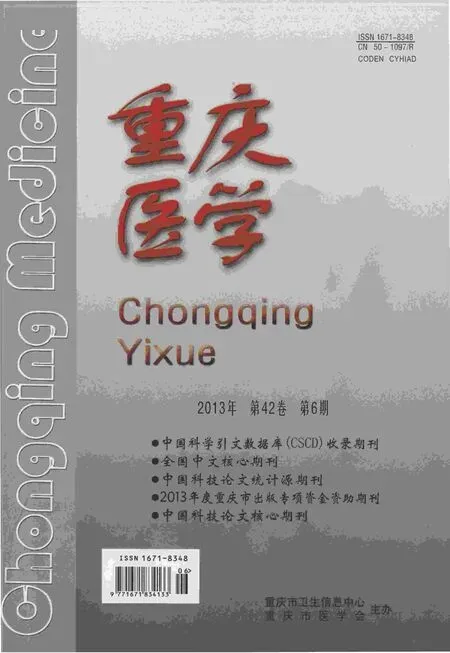降钙素原诊断重症急性胰腺炎的系统评价
朱喜丹,田 刚,刘靳波,黄远帅
(泸州医学院附属医院检验科,四川泸州 646000)
急性胰腺炎是多种病因导致胰酶在胰腺内被激活后引起胰腺组织自身消化、水肿、出血甚至坏死的炎症反应。轻者以胰腺水肿为主,病情呈自限性,预后良好,少数患者胰腺出血坏死,常继发感染、腹膜炎和休克等多种并发症,病死率高[1]。近年的研究表明急性胰腺炎时,胰腺组织的损伤过程中产生一系列炎性介质引起全身炎症反应综合征(systemic inflammatory response syndrome,SIRS)进而导致全身多器官功能衰竭(multiorgan dysfunctionsyndrome,MODS),而这一系列的炎性介质的激活参与了重症急性胰腺炎(severity of acute pancreatitis,SAP)进展,并与其高病死率息息相关[2]。
降钙素原(procalcitonin,PCT)是无激素活性的降钙素前肽物质,参与体内的钙平衡[3]。当严重细菌、真菌、寄生虫感染及脓毒症和多脏器功能衰竭时它在血浆中的水平升高。自身免疫、过敏和病毒感染时PCT不会升高。局部有限的细菌感染、轻微的感染和慢性炎症不会导致其升高。PCT水平的升高出现在严重休克、SIRS和MODS,PCT反映了全身炎症反应的活跃程度[4]。正是它的这些特性,使得PCT在许多临床领域得到广泛的应用,可用于鉴别自身免疫病活动与是否同时合并感染、监测器官移植、判断脓毒症和菌血症者抗菌药物治疗的有效性、作为急性胰腺炎发生感染并发症的早期诊断指标等[5-9]。
近年来,一些研究显示PCT作为SAP的预测标志物具有较好的灵敏度和特异度[10-12]。但Shafiq等[13]对4篇纳入文献做了一个Meta分析,得出PCT不是一个较好的SAP预测物。基于这种研究现状,作者系统地检索了文献,严格制定了纳入和排除标准,系统地评价当前PCT预测SAP的文献质量及作为SAP诊断标志物的价值。
1 资料与方法
1.1 检索策略和文献选择 系统地检索了MEDLINE,Pub Med,the Cochrane clinical trials register Database在1956年1月至2011年12月发表的有关PCT诊断SAP的文献,语言限定为“English”。检索策略使用以下关键词:“acute pancreatitis”and/or“severe acute pancreatitis”and/or“infected pancreatic necrosis”combined with “procalcitonin”and/or“calcitonin”。
1.2 数据提取 搜索和筛选文献,并提取数据。从每一篇文献中提取:第一作者、出版年份、人口学特征、研究设计、纳入和排除标准、研究对象数目、确定SAP诊断标准方法(金标准)等制作评价表。
1.3 纳入标准 所有报道了将测量血清PCT含量与SAP金标准相比较的具体数据的文献均应纳入系统评价,排除这些研究中没有严重程度分级的文献。对判定有异议者可进行研究小组协商,并请教统计学专家及联系文章的通讯作者。
1.4 排除标准 没有将检测方法与金标准比较者(包括综述和个案报道)须排除;排除动物实验;无诊断终点值(灵敏度、特异度等)者排除。使用诊断性研究的质量评价工具(quality assessment of studies of diagnostic accuracy,QUADAS)作为参考标准评价文献的质量[14]。
1.5 统计学处理 对纳入文献进行数据提取构建2×2四格表,并使用“Meta分析报告质量”(quality of reporting of metaanalyses,QUORUM)指南进行 Meta分析,合并了灵敏度、特异度、阴性和阳性预测值并计算了95%CI。最后通过绘制总受试者工作特征(summary receiver operator characteristic,SROC)曲线及估计曲线下面积来说明PCT作为SAP预测标志物的诊断价值[15],使用的统计软件为Meta-Disc1.4。
2 结 果
通过纳入和排除标准,排除了重复文献129篇、个案报道3篇、综述21篇、动物实验5篇、非相关研究6篇、诊断终点值不符5篇、不能提取数据1篇、重复发表1篇、其他7篇,共筛选出12篇文献,共计826例受试对象纳入了Meta分析,基本情况见图1。12篇纳入文献的研究情况及人口学特征见表1。
对12篇文献进行数据提取构建2×2表,分别得到真阳性数(a)、假阳性数(b)、假阴性数(c)、真阴性数(d)等基础统计数值,将数值录入到诊断性试验专有的统计学软件Meta-Disc1.4中,得到PCT预测SAP的合并灵敏度和特异度分别为72%和86%,见图2;诊断优势比(DOR)为14.9(95%CI=5.6~39.8),见图3;SROC曲线下面积为0.87,见图4。对数据进行异质性检验,其Q为28.56(P<0.01)。所有的纳入文献均为前瞻性设计,12篇文献中有8篇的STARD评分超过16分。对这8篇文献进行亚组分析,其合并灵敏度和特异度分别为0.73(95%CI=0.66~0.8),0.90(95%CI=0.87~0.93);SROC曲线下面积为0.91。8篇文献间无显著性异质性差异(Q=3.85,P=0.26)。

图1 QUORUM图解文献选择过程

图2 PCT预测SAP的灵敏度和特异度及合并效应

表1 纳入文献的人口学特征及研究情况

续表1 纳入文献的人口学特征及研究情况

图3 PCT预测SAP的诊断优势比及合并效应

图4 PCT预测SAP的SROC曲线图
3 讨 论
目前诊断急性胰腺炎的方法主要有:临床体征、影像学检查和淀粉酶、脂肪酶等血清学标志物检测[28]。临床体征不具有特异性,只能作为辅助诊断的一部分;增强CT是目前诊断胰腺坏死的主要方法之一,但评分方法粗略,且对疾病进展的判断往往滞后于病情的发展;淀粉酶、脂肪酶等血清学标志物的特异性不强,且检测有“窗口期”,不能全面而准确的评估SAP。因此发现或者发展一种新的检测方法或标志物,将推动SAP的诊断及治疗[29-30]。
近年来,许多研究表明,血清PCT可以有效地预测SAP的发展,本研究的目的就是为了证实PCT预测SAP的可靠性、价值大小及合理性。研究纳入的12篇文献均为前瞻性研究,且具有较好的研究质量,然而,作者在研究的过程中却发现这些原始研究间存在着一定的异质性。比如说样本采集时间不统一;PCT检测方法各异;以及诊断阈值在不同的范围波动等,这些都可能造成研究的偏移。选择一致性较好的文献(8篇)进行亚组分析,异质性程度大大降低了,说明文献的选择及质量的评估可影响系统评价的结果。在报告质量的评价中,虽然采取了广泛的检索策略,但检索语种仅限于英文,可能会造成漏检及语种偏倚。
与其他诊断标志物一样,PCT诊断SAP的准确性也要依赖于诊断阈值的选择,不同疾病阶段采集的样本和检测手段的不一致性会影响诊断阈值的大小。尽管目前还没有统一的意见关于PCT诊断SAP到底应该采用多大的诊断阈值才合适,但从本文的综合研究分析,诊断界值为0.5ng/mL时,诊断的灵敏度和特异度相对较高,异质性检验也没有较大的异质性。
综上所述,血清PCT的检测可能成为预测SAP的有效手段,然而由于研究数量所限以及缺乏成本效果及安全性的评估,尚需更多的一致性文献的支持。
[1]DiMagno MJ,DiMagno EP.New advances in acute pancreatitis[J].Curr Opin Gastroenterol,2007,23(5):494-501.
[2]Parks RW.Association between early systemic inflammatory response syndrome,severity of multi-organ dysfunction and death in acute pancreatitis[J].Surg,2006,93(9):738-744.
[3]Endo S,Aikawa N,Fujishima S.Usefulness of procalcito-nin serum level for the discrimination of severe sepsis from sepsis:a multicenter prospective study[J].Infect Chemother,2008,14(3):244-249.
[4]Rustici MC,Chiappini E,Salvadori M.Clinical usefulness of the semiquantitative procalcitonin test in the diagnosis of bacterial infections in a third level children′s hospital[J].Clin Lab,2011,57(7/8):497-506.
[5]Tamaki K,Kogata Y,Sugiyama D,et al.Diagnostic accuracy of serum procalcitonin concentrations for detecting systemic bacterial infection in patients with systemic autoimmune diseases[J].Rheumatol,2008,35(1):114-119.
[6]Madershahian N,Wittwer T,Strauch J.Kinetic of procalcitonin in the early postoperative course following heart transplantation[J].Card Surg,2008,23(5):468-473.
[7]Sato H,Tanabe N,Murasawa A,et al.Procalcitonin is a specific marker for detecting bacterial infection in patients with rheumatoid arthritis[J].Rheumatol,2012,39(8):1517-1523.
[8]Rau BM,Kemppainen EA,Gumbs AA,et al.Early assessment of pancreatic infections and overall prognosis in severe acute pancreatitis by procalcitonin(PCT):aprospective international multicenter study[J].Surg,2007,245(8):745-754.
[9]Purkayastha S,Chow A,Athanasiou T,et al.Does serum procalcitonin have a role in evaluating the severity of acute pancreatitis.a question revisited[J].Surg,2006,30(20):1713-1721.
[10]Dambrauskas Z,Pundzius J,Barauskas G.Predicting development of infected necrosis in acute necrotizing pancreatitis[J],Med(Kaunas),2006,42(5):441-449.
[11]Bulbuller N,Dogru O,Ayten R,et al.Procalcitonin is a predictive marker for severe acute pancreatitis[J].Ulus Travma Acil Cerrahi Derg,2006,12(1):115-120.
[12]Mofidi R,Suttie SA,Patil PV.The value of procalcitonin at predicting the severity of acute pancreatitis and development of infected pancreatic necrosis:systematic review[J].Surg,2009,146(1):72-81.
[13]Shafiq N,Malhotra S,Bhasin DK,et al.Estimating the diagnostic accuracy of procalcitonin as a marker of the severity of acute pancreatitis:a meta-analytic approach[J].JOP,2005,6(3):231-237.
[14]Whiting P,Rutjes AWS,Reitsma JB,et al.The development of quadas:a tool for the quality assessment of studies of diagnostic accuracy included in systematic reviews[J].BMC Med Res Methodol,2003,3(1):25-30.
[15]Stroup DF,Berlin JA,Morton SC,et al.Meta-analysis of observational studies in epidemiology:aproposal for reporting.meta-analysis of observational studies in epidemiology(MOOSE)group[J].Am Med Ass,2000,283(20):2008-2012.
[16]Rau B,Steinbach G,Gansauge F,et al.The potential role of procalcitonin and interleukin-8in the prediction of infected necrosis in acute pancreatitis[J].Gut,1997,41(9):832-840.
[17]Mandi Y,Farkas G,Takacs T,et al.Diagnostic relevance of procalcitonin,IL-6,and sICAM-1in the prediction of infected necrosis in acute pancreatitis[J].Pancreatol 2000,28(1):41-49.
[18]Pindak D,Parrak V,Pechan J,et al.The clinical value of the procalcitonin in prediction of severity and outcome in acute pancreatitis[J].Hepatogastroenterology,2003,50(2):88-91.
[19]Pezzilli R,Melzi dEril GV,Morselli-Labate AM,et al.Serum amyloid a,procalcitonin,and C-reactive protein in early assessment of severity of acute pancreatitis[J].Dig Dis Sci,2000,45(10):1072-1078.
[20]Melzi DEril GV,Merlini G,Finazzi S,et al.Procalcitonin is not a reliable marker for the assessment of severity in acute pancreatitis without infectious complications[J].Clin Chem,2000,46(4):428-430.
[21]Frasquet J,Saez J,Trigo C,et al.Earlymeasurement of procalcitonin does not predict severity inpatients with acute pancreatitis[J].Surg,2003,90(10):1129-1130.
[22]Kylanpa-Back ML,Takala A,Kemppainen E,et al.Procalcitonin strip test in the early detection of severe acute pancreatitis[J].Surg,2001,88(3):222-227.
[23]Kylanpaa-Back ML,Takala A,Kemppainen EA,et al.Procalcitonin,soluble interleukin-2receptor,and soluble E-selectin in predicting the severity of acute pancreatitis[J].Crit Care Med,2001,29(1):63-69.
[24]Ammori BJ,Becker KL,Kite P,et al.Calcitonin precursors:early markers of gut barrier dysfunction in patients with acute pancreatitis[J].Pancreas,2003,27(3):239-243.
[25]Modrau IS,Floyd AK,Thorlacius-Ussing O.The clinical value of procalcitonin in early assessment of acute pancreatitis[J].Gastroenterol,2005,100(17):1593-1597.
[26]Bulbuller N,Dogru O,Ayten R,et al.Procalcitonin is a predictive marker for severe acute pancreatitis[J].Ulus Travma Acil Cerrahi Derg,2006,12(1):115-120.
[27]Rau BM,Kemppainen EA,Gumbs AA,et al.Early assessment of pancreatic infections and overall prognosis in severe acute pancreatitis by procalcitonin (PCT):aprospective international multicenter study[J].Ann Surg,2007,245(8):745-754.
[28]中华医学会外科学分会胰腺外科学组.重症急性胰腺炎诊治指南[J].中华外科学杂志,2007,45(11):34-36.
[29]Jennifer K.Acute pancreatitis:diagnosis,prognosis,and treatment[J].Am Fam Physician,2007,75(10):1513-1520.
[30]Borie F,Fingerhut A,Millat B.Acute biliary pancreatitis,endoscopy,and laparoscopy[J].Surgical Endoscopy,2009,17(8):1175-1180.

